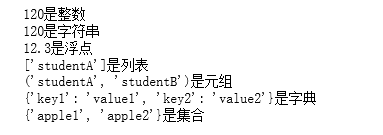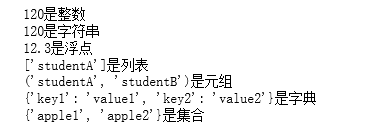python的数据类型有:数字(int)、浮点(float)、字符串(str),列表(list)、元组(tuple)、字典(dict)、集合(set)
一般通过以下方法进行判断:
1、isinstance(参数1,参数2)
描述:该函数用来判断一个变量(参数1)是否是已知的变量类型(参数2) 类似于type()
参数1:变量
参数2:可以是直接或间接类名、基本类型或者由它们组成的元组。
返回值: 如果对象的类型与参数二的类型(classinfo)相同则返回 True,否则返回 False
例子:
|
1
2
3
4
5
6
7
8
9
10
11
12
13
14
15
16
17
18
19
20
21
22
23
24
25
26
27
28
29
30
31
32
33
34
35
36
37
38
39
40
41
42
43
44
45
|
#判断变量类型的函数def typeof(variate): type=None if isinstance(variate,int): type = "int" elif isinstance(variate,str): type = "str" elif isinstance(variate,float): type = "float" elif isinstance(variate,list): type = "list" elif isinstance(variate,tuple): type = "tuple" elif isinstance(variate,dict): type = "dict" elif isinstance(variate,set): type = "set" return type# 返回变量类型def getType(variate): arr = {"int":"整数","float":"浮点","str":"字符串","list":"列表","tuple":"元组","dict":"字典","set":"集合"} vartype = typeof(variate) if not (vartype in arr): return "未知类型" return arr[vartype]#判断变量是否为整数money=120print("{0}是{1}".format(money,getType(money)))#判断变量是否为字符串money="120"print("{0}是{1}".format(money,getType(money)))money=12.3print("{0}是{1}".format(money,getType(money)))#判断变量是否为列表students=['studentA']print("{0}是{1}".format(students,getType(students)))#判断变量是否为元组students=('studentA','studentB')print("{0}是{1}".format(students,getType(students)))#判断变量是否为字典dictory={"key1":"value1","key2":"value2"}print("{0}是{1}".format(dictory,getType(dictory)))#判断变量是否为集合apple={"apple1","apple2"}46 print("{0}是{1}".format(apple,getType(apple))) |
返回:

2、通过与已知类型的常量进行比较
例子:
|
1
2
3
4
5
6
7
8
9
10
11
12
13
14
15
16
17
18
19
20
21
22
23
24
25
26
27
28
29
30
31
32
33
34
35
36
37
38
39
40
41
42
43
44
45
46
|
#判断变量类型的函数def typeof(variate): type1 = "" if type(variate) == type(1): type1 = "int" elif type(variate) == type("str"): type1 = "str" elif type(variate) == type(12.3): type1 = "float" elif type(variate) == type([1]): type1 = "list" elif type(variate) == type(()): type1 = "tuple" elif type(variate) == type({"key1":"123"}): type1 = "dict" elif type(variate) == type({"key1"}): type1 = "set" return type1# 返回变量类型def getType(variate): arr = {"int":"整数","float":"浮点","str":"字符串","list":"列表","tuple":"元组","dict":"字典","set":"集合"} vartype = typeof(variate) if not (vartype in arr): return "未知类型" return arr[vartype]#判断变量是否为整数money=120print("{0}是{1}".format(money,getType(money)))#判断变量是否为字符串money="120"print("{0}是{1}".format(money,getType(money)))money=12.3print("{0}是{1}".format(money,getType(money)))#判断变量是否为列表students=['studentA']print("{0}是{1}".format(students,getType(students)))#判断变量是否为元组students=('studentA','studentB')print("{0}是{1}".format(students,getType(students)))#判断变量是否为字典dictory={"key1":"value1","key2":"value2"}print("{0}是{1}".format(dictory,getType(dictory)))#判断变量是否为集合apple={"apple1","apple2"}print("{0}是{1}".format(apple,getType(apple))) |
返回:

补充:
isinstance() 与 type() 区别:
- type() 不会认为子类是一种父类类型,不考虑继承关系。
- isinstance() 会认为子类是一种父类类型,考虑继承关系。
如果要判断两个类型是否相同推荐使用 isinstance()。
以上就是如何在python中判断变量的类型的详细内容,更多关于Python判断变量类型的资料请关注服务器之家其它相关文章!
原文链接:https://www.cnblogs.com/xmnote/p/9334743.html










